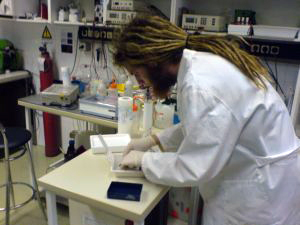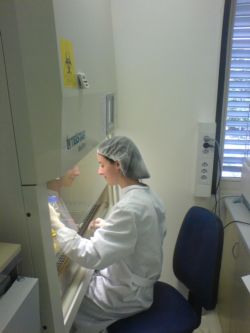Ljubljana to Verily
A conversation with Peter Cimermancic on his iGEM and After iGEM journey
Written and Interviewed by Amy Chen and Hassnain Qasim Bokhari
2006 was the year when iGEM went international, 37 teams were participating and among these teams, there was one lead by Professor Roman Jerala and Marko Dolinar. Like many other non-US teams, it was the first time a Slovenian team participated in the competition. They surprised many as they went on to win the Grand Prize. Their victory was not only momentous for the 2006 team members, but also it helped in setting an inspiring example for future teams from Slovenia, and those countries which were participating for the first time, that in the iGEM Competition they can equally compete with the prestigious universities of the world.
Peter Cimermančič, a 2nd year Biochemistry undergrad, was on such student who was inspired by the 2006 team’s victory, and it motivated him to be a part of the iGEM Competition in 2007.
We had a chance to reconnect with Peter who was now working at Verily Life Sciences (formerly Google Life Sciences), where his work involves using machine learning to interpret raw lab data as part of their search for new disease biomarkers. During his PhD, he mainly spent his time to model protein structures, but now has the opportunity to work on the data gained from actual patients.
Speaking on the effect of 2006 team’s achievement he reminisced with a smile on his face, “At the time, I didn’t expect science in our country to be comparable with that of world-renowned universities, and I kind of suffered from the Impostor Syndrome. You know a feeling that you aren’t as good as others or the students here aren’t as good as the ones at the top US universities, because they have a better research ecosystem. However, when Slovenia won in 2006 that gave us confidence. So I was like let’s give iGEM a shot.”
From applying for the team to presenting their work at the Giant Jamboree, it was all new and exciting for Peter.
“I remember writing a proposal and then going through interviews with Roman and Marko. After that, the three months of research was an amazing learning experience for me followed by going to US for the Giant Jamboree, where I listened and watched crazy projects, that opened a new world of Science to me.”
The participation set the tone for what Peter went on to do professionally with his research and career. It was both a realization and commitment, as he cheerfully said, “I realized that I wasn’t born to do wet-lab science. I really enjoyed doing Computational Biology. iGEM was my first chance to work independently in the lab, I got to do modeling and enjoyed doing the computational stuff more than the wet-lab and that ended up shaping what I chose to do next. So where I am now, it was basically ignited by iGEM.”
University of Ljubljana’s 2007 iGEM Team Slovenia
While Peter hasn’t been able to attend the more recent versions of the Giant Jamboree, he has been keeping an eye on the projects, “I like that all the problems that teams are working on now are more practical. In the beginning there were projects which seemed pretty far away from being a viable product, although the teams had done a very great job on them. So I like seeing that teams are now trying to solve local issues through their participation in the iGEM Competition. Imagine a team successfully developing a working proof-of-concept or a prototype, that can do wonders for their community.”
The iGEM Competition brings together a multi-disciplinary team and hence gives a much needed space for diverse set of ideas to flourish. During his time in the Competition his appreciation for multidisciplinary research inflated and became infectious.
“That’s the only way I do science now. The best thing about doing Science today, is that you can’t work all by yourself. Problems can only be solved when you have a diverse team working together on it. For example, wet-lab research gives a significant amount of information and data, which requires more expertise to analyze and process it, that’s where dry-lab comes in. Today, working alone is difficult, you can’t do that. Even at University of California, San Francisco, we were constantly trying to equip scientists from distinct disciplines with diverse skills. The setup of iGEM is great. It brings diverse skill sets together very early on, right at the time of the ideation process.”
Human Practices wasn’t a part of the iGEM Competition at the time Peter participated, yet his team did a lot of work on Education. Peter gave the credit of their work to Roman and Marko’s vision of promoting iGEM to not just the scientific community but the public at large. “I remember that each one of us went to many interviews on National TV and Radio, we gave seminars to the public as well; so that we could use this opportunity to educate people about Synthetic Biology and its potential to solve major healthcare issues.”
Peter claimed that although Human Practices wasn’t a part of the iGEM Competition at that time but its inclusion over the years has ensured that the public receives responsible and credible knowledge about Synthetic Biology. “When you engage in a conversation about GMO, it makes the public fearful, but when you talk with them about all the new therapies being developed at the behest of Synthetic Biology, it generates a positive view and I believe that iGEM has a very powerful role to play in it.”
After his participation in the iGEM Competition, Peter went on to do his PhD and post-doc from UCSF, but for him that’s not where he stops. He has higher goals, he wants to translate his research and build it up to help treat patients. Right now his research work at Verily brings him a step closer to his goal.
Although today his work mostly relates to bioinformatics and machine learning, he still follows the field of Synthetic Biology. He has high hopes for the future of Synthetic Biology, “I think it will be very interesting since now Synthetic Biology has entered into the therapeutic world (eg, CAR-T cells). Now that we have stepped out of the door, people will be paying more attention to Synthetic Biology and it will be great to see how iGEM grows in this scenario, since many of the teams, like I have said before, work on solving important problems. There are many challenges and all these teams are working on them, from food to energy, healthcare and agriculture.”
The conversation finished with Peter hailing the power of iGEMers and mentioning his strong expectations from the community, “Through iGEM, many passionate individuals get an opportunity to work collectively on diverse set of problems. The work as a team and have this opportunity to make in impact in the world. Some of them have already done that and I believe many more will do it in the future.
Team Slovenia 2007 at the Giant Jamboree with their award for the best Health & Medicine project.
The iGEM Digest is a collection of stories from the iGEM Community. More information on the iGEM Digest can be found here: after.igem.org/page/igem-digest












